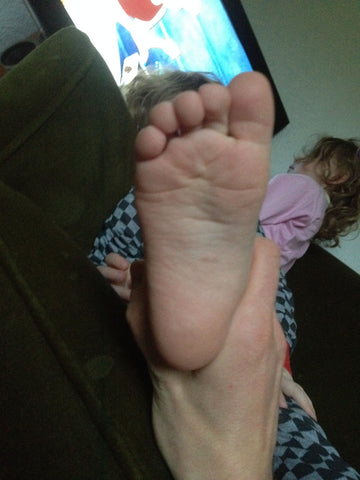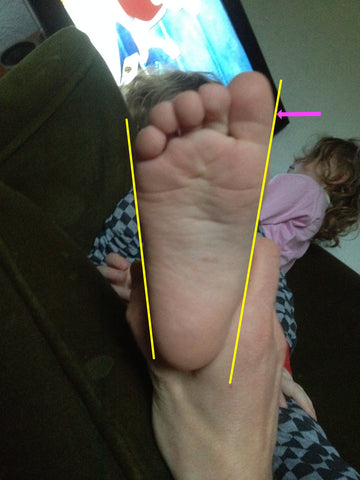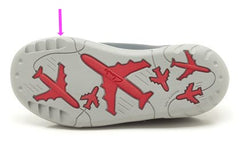WITH TEAM BEAR-FOOT!
This article come from a series of informal discussions with various friends and customers on natural foot development. As children's feet grow little consideration appears to be given by the mainstream shoe manufacturers to natural foot development. I wonder, have these shoes designers actually looked at children feet? As such, I felt compelled and inspired to write this article.
In the last article we looked at how my children's feet interacted with shoes having different sole shapes (by drawing around the shoes). In this article we'll follow up to look at my children's feet (Team Bear-Foot) and show what it is about their feet that give rise to anatomically specific requirements for children's shoe design.
Let's meet the feet......
If we look at Chewey's first (left). We see a normal 2 year old's foot. The arch not yet fully formed, the feet look flat, there is plenty of fat around the foot to give the shock absorbency that the developed arch will eventually provide. Look at the overall shape of the foot. It's triangular. It does not curve or taper at the big toe. At this point in it's development we expect there to be 22 bones in each foot interconnected with cartilage. It is susceptible to external influences (i.e. shoes).
Now look at Popsy's foot (right). We see a 4 year old foot. A more developed arch and a distinct reduction of fat in the foot (in part due to the arch development). We can also see a triangular foot shape and observe a gap between the big toe and the second toe - the result of the natural tendency of the feet to splay when unhindered by poor shoe design. At this stage in the foot's development we expect there to be up to 45 bones per foot. In the space of 2 years that's a big change.
I've highlighted these points on the same images below indicating the natural (triangular) shape of the foot and the widest point of my children's feet with a pink arrow.
Image above shows the triangle shape of children's feet, and the pink arrow indicates the widest part of the foot.THE FOOT IS WIDEST AT THE BIG TOE - SO WHAT'S THE BIG DEAL?
From the Society for Chiropodists and Podiatrists -
'The function of the toes, especially the big toe, is to help us balance, and to propel us forward during walking or running. The 14 bones of the toes are among the smallest in the body, and, not surprisingly, things can and often do go wrong. Some problems begin in childhood and may go unnoticed. Others begin later on in life, perhaps as the result of injury or the added pressure of incorrect footwear.'
'The big toe is the final sequence in a box of tricks that nature provides for us through our feet.'
(Mr Kartik Hariharan is one of the country’s leading foot and ankle surgeons).
The big toe is essential for balance and for our forward movement. And remember, by forward motion, we are talking interaction in the proper [kinetic] function of ankles, knees, hips and lower back (and beyond)......So for our children the big toe and it's natural development is a BIG DEAL.
SO WHY IS PROVISION FOR THIS VITAL PART OF THE FOOT SO LITTLE CONSIDERED IN MOST MAINSTREAM SHOE DESIGNS?
The answer: We don't know! That's why we started Bear-Foot.
Let's look at some mainstream shoe soles and some of our soles and see which fit the feet above best. I've marked the widest point of the shoe with an arrow.
It is seen in the photos above that the toe box is already tapering against the big toe much before the end of the shoe.
In our previous blog post, we demonstrated that our shoes have a wide toe box giving toes the wriggle room that they need.
If you liked this article then please share. And keep your eyes out for future blog posts tracking the adventures of Team Bear-Foot!
For now, take care.
Phil









Interesting site and lovelly cutie feeties. :)
ReplyDelete